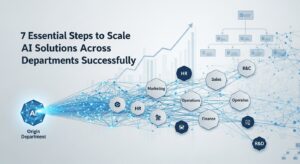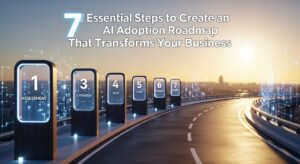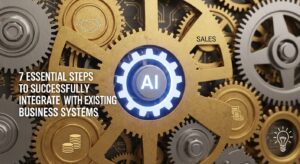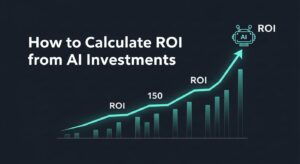AI implementation in Pakistan is becoming a key driver of digital transformation, reshaping how businesses compete and grow.
As the world’s fifth-most populous country with a rapidly growing economy, Pakistan presents unique opportunities and challenges for artificial intelligence implementation. The question isn’t whether AI will transform Pakistani businesses—it’s how quickly and effectively organizations can adapt to harness its power.
Consider this: what specific challenges does your business face that could potentially be solved through intelligent automation or data-driven insights? Understanding your pain points is the first step toward identifying where AI can create the most value.
The Pakistani business landscape, from Karachi’s bustling financial district to Lahore’s manufacturing hubs and Islamabad’s growing tech sector, is ripe for AI transformation. However, successful implementation requires more than just adopting the latest technology—it demands a strategic approach that considers local market dynamics, cultural factors, and regulatory environments.
AI Implementation in Pakistan’s Business Landscape
Key Sectors Driving AI Implementation in Pakistan
Pakistan’s AI ecosystem is experiencing rapid growth, driven by several key factors:
- Government Initiatives: The Digital Pakistan vision and initiatives like the National Incubation Center network have created supportive infrastructure. The government’s emphasis on digitization across sectors—from agriculture to healthcare—has opened new avenues for AI implementation.
- Educational Foundation: With institutions like LUMS, FAST, and NUST producing skilled computer science graduates, Pakistan has a growing pool of AI talent. However, there’s still a significant gap between industry demand and available expertise.
- Economic Drivers: The need to improve efficiency and competitiveness in global markets has pushed businesses to explore AI solutions. From textile manufacturing to financial services, companies are seeking ways to optimize operations.
Before diving deeper, what do you think are the most significant barriers Pakistani businesses face when considering AI implementation? Understanding these challenges helps us develop targeted strategies to overcome them.
Key Sectors Leading AI Adoption
- Financial Services: Banks like HBL and MCB have pioneered chatbot technologies and fraud detection systems. The State Bank of Pakistan’s regulatory sandbox has encouraged fintech innovation.
- Telecommunications: Companies like Jazz and Telenor use AI for network optimization and customer service. The massive subscriber base provides rich data for machine learning applications.
- E-commerce: Platforms like Daraz leverage AI for recommendation engines, inventory management, and logistics optimization.
- Agriculture: Given that agriculture employs nearly 40% of Pakistan’s workforce, AI applications in crop monitoring, pest detection, and yield prediction offer tremendous potential.
Strategic Framework for AI Implementation
Step 1: AI Readiness Assessment
Before implementing any AI solution, businesses must evaluate their current capabilities across multiple dimensions:
- Data Infrastructure: How mature is your data collection, storage, and processing infrastructure? AI systems require clean, accessible, and relevant data. Many Pakistani businesses still rely on paper-based systems or fragmented digital records.
- Technology Foundation: Assess your current IT infrastructure. Cloud computing capabilities, processing power, and network reliability are foundational requirements for AI systems.
- Human Capital: Evaluate your team’s technical skills and readiness for AI integration. This includes not just technical staff but also management and end-users who will interact with AI systems.
- Financial Resources: AI implementation requires significant investment in technology, training, and ongoing maintenance. Develop realistic budget projections that account for both initial costs and long-term ROI.
What aspects of this assessment do you think would be most challenging for a typical Pakistani SME? This self-reflection helps identify where additional support or phased approaches might be necessary.
Step 2: Identifying AI Use Cases
The key to successful AI implementation lies in identifying the right problems to solve. Consider these categories:
- Process Automation: Repetitive tasks that consume significant human resources. Examples include invoice processing, customer inquiry routing, and basic data entry.
- Predictive Analytics: Using historical data to forecast future trends. This could include demand forecasting, maintenance scheduling, or customer churn prediction.
- Customer Experience Enhancement: Personalization engines, recommendation systems, and intelligent customer service tools.
- Quality Control and Monitoring: Automated inspection systems, anomaly detection in manufacturing processes, and real-time performance monitoring.
Think about your own business context: which of these categories aligns most closely with your immediate needs and available resources?
Step 3: Developing Your AI Strategy
Vision and Objectives: Clearly define what you want to achieve with AI. Is it cost reduction, revenue enhancement, customer satisfaction improvement, or competitive advantage?
Phased Implementation Plan: Rather than attempting a comprehensive overhaul, develop a phased approach that allows for learning and adjustment:
- Pilot Phase: Select a low-risk, high-impact use case for initial implementation
- Expansion Phase: Scale successful pilots and introduce additional use cases
- Integration Phase: Integrate AI systems across business processes
- Innovation Phase: Develop proprietary AI capabilities and explore advanced applications
Success Metrics: Establish clear KPIs for measuring AI success. These might include cost savings, efficiency improvements, error reduction rates, or customer satisfaction scores.
Building AI Capabilities
Talent Development and Acquisition
Pakistan faces a significant AI talent gap, with demand far exceeding supply. Here’s how businesses can address this challenge:
- Internal Training Programs: Invest in upskilling existing employees. Focus on both technical skills (data analysis, machine learning basics) and AI literacy for non-technical staff.
- Partnerships with Universities: Collaborate with local institutions to develop talent pipelines. Consider internship programs, research partnerships, and sponsored projects.
- Remote and Freelance Talent: Leverage Pakistan’s growing remote work capabilities to access global AI expertise while building local knowledge.
- Hybrid Approach: Combine local talent with international expertise through consulting partnerships or remote team collaborations.
What strategies do you think would be most effective for your organization’s specific needs and constraints?
Technology Infrastructure Development
- Cloud Strategy: Given the high costs of on-premises infrastructure, cloud adoption is often the most practical path for Pakistani businesses. Major cloud providers offer AI/ML services that reduce technical complexity.
- Data Management Systems: Implement robust data governance frameworks. This includes data quality processes, security protocols, and compliance measures aligned with local regulations.
- Integration Capabilities: Ensure new AI systems can integrate with existing business applications. This often requires API development and middleware solutions.
Vendor Selection and Partnerships
Local vs. International Solutions: Balance between global AI platforms and local solution providers. Local vendors may offer better cultural understanding and support, while international platforms provide advanced capabilities.
Partnership Models: Consider various collaboration approaches:
- Technology licensing
- Joint ventures
- Consulting partnerships
- System integration services
Sector-Specific Implementation Strategies
Manufacturing and Industry 4.0
Pakistan’s manufacturing sector, particularly textiles, automotive, and chemicals, can benefit significantly from AI implementation:
- Predictive Maintenance: Implement sensors and AI algorithms to predict equipment failures before they occur, reducing downtime and maintenance costs.
- Quality Control: Use computer vision systems to automate quality inspection processes, improving consistency and reducing human error.
- Supply Chain Optimization: Leverage AI for demand forecasting, inventory optimization, and logistics planning.
- Energy Management: Implement smart systems to optimize energy consumption, particularly important given Pakistan’s energy challenges.
Consider a textile manufacturer in Faisalabad: what would be the most logical starting point for AI implementation, given typical resource constraints and operational priorities?
Financial Services and Fintech
The financial sector in Pakistan is experiencing rapid digitization, creating opportunities for AI integration:
- Risk Assessment: Develop AI models for credit scoring, particularly for underbanked populations using alternative data sources.
- Fraud Detection: Implement real-time transaction monitoring systems to detect and prevent fraudulent activities.
- Customer Service: Deploy chatbots and virtual assistants for basic customer inquiries and account management.
- Investment Advisory: Develop robo-advisory services for wealth management and investment recommendations.
Agriculture and Food Processing
Given agriculture’s importance to Pakistan’s economy, AI applications in this sector have tremendous potential:
- Precision Agriculture: Use satellite imagery and IoT sensors for crop monitoring, soil analysis, and irrigation optimization.
- Pest and Disease Detection: Implement computer vision systems to identify crop diseases and pest infestations early.
- Market Intelligence: Develop price prediction models and market demand forecasting for farmers and traders.
- Food Safety: Implement AI-powered traceability systems to ensure food quality and safety throughout the supply chain.
Healthcare and Life Sciences
Pakistan’s healthcare sector faces significant challenges that AI can help address:
- Diagnostic Assistance: Develop AI systems to assist doctors in medical imaging interpretation and disease diagnosis.
- Drug Discovery: Collaborate with pharmaceutical companies to accelerate drug development processes.
- Healthcare Management: Implement systems for patient flow optimization, resource allocation, and predictive analytics for epidemic preparedness.
- Telemedicine Enhancement: Integrate AI with telemedicine platforms to improve remote healthcare delivery.
Overcoming Implementation Challenges
Regulatory and Compliance Considerations
Pakistan’s regulatory environment for AI is still evolving. Businesses must navigate several key areas:
- Data Protection: Understand and comply with local data protection requirements. While Pakistan doesn’t have comprehensive GDPR-like legislation yet, privacy concerns are growing.
- Financial Regulations: For financial services, ensure AI systems comply with State Bank of Pakistan regulations and guidelines.
- Industry-Specific Compliance: Different sectors have specific regulatory requirements that must be considered in AI implementation.
- Cross-Border Data Transfer: Understand regulations around data transfer for businesses using international AI services.
Cultural and Change Management
- Digital Literacy: Address varying levels of digital comfort among employees and customers. Implement comprehensive training programs and gradual transition strategies.
- Trust Building: Build confidence in AI systems through transparency, explainability, and consistent performance demonstration.
- Communication Strategy: Develop clear communication about AI benefits and address concerns about job displacement through retraining and role evolution programs.
Technical Challenges
- Data Quality: Address common data quality issues including incomplete records, inconsistent formats, and lack of standardization.
- Infrastructure Limitations: Work around connectivity issues, power supply challenges, and hardware constraints common in Pakistani business environments.
- Integration Complexity: Manage the complexity of integrating AI systems with legacy business applications and processes.
ROI and Performance Measurement
Defining Success Metrics
Financial Metrics:
- Cost reduction percentages
- Revenue enhancement
- Productivity improvements
- Return on investment timelines
Operational Metrics:
- Process efficiency improvements
- Error reduction rates
- Customer satisfaction scores
- Employee productivity measures
Strategic Metrics:
- Market share improvements
- Competitive advantage gains
- Innovation capability enhancement
- Digital transformation maturity
How would you prioritize these different types of metrics for your organization’s AI initiatives?
Implementation Timeline and Milestones
| Phase & Timeline | Key Activities |
|---|---|
| Phase 1 (Months 1–6): Foundation Building | – Complete AI readiness assessment – Develop AI strategy and roadmap – Establish governance framework – Begin talent development programs |
| Phase 2 (Months 7–18): Pilot Implementation | – Launch first AI pilot project – Develop data infrastructure – Establish vendor partnerships – Create change management programs |
| Phase 3 (Months 19–30): Scaling and Integration | – Scale successful pilots – Integrate AI systems with core business processes – Expand team capabilities – Measure and optimize performance |
| Phase 4 (Months 31+): Innovation and Advanced Applications | – Develop proprietary AI capabilities – Explore advanced use cases – Build competitive advantages – Establish innovation partnerships |
Future Outlook and Emerging Trends
Emerging Technologies
- Edge AI: As internet connectivity improves, edge computing will enable real-time AI processing in remote areas of Pakistan.
- 5G Integration: The rollout of 5G networks will unlock new AI applications requiring high-speed, low-latency connections.
- Quantum Computing: While still emerging, quantum computing may eventually impact AI capabilities in complex optimization problems.
Industry Evolution
- Regulatory Development: Expect more comprehensive AI governance frameworks as the technology matures.
- Talent Market: The AI talent pool will grow, but competition will intensify. Organizations that invest early in talent development will have competitive advantages.
- Cost Reduction: AI implementation costs will decrease as technologies mature and local service providers develop capabilities.
Economic Impact
AI implementation has the potential to significantly impact Pakistan’s economic development by:
- Improving industrial competitiveness
- Enhancing service delivery
- Creating new job categories
- Attracting foreign investment
- Supporting export growth
Practical Implementation Checklist
Pre-Implementation Assessment
- [ ] Conduct comprehensive AI readiness assessment
- [ ] Identify and prioritize potential use cases
- [ ] Evaluate available talent and skill gaps
- [ ] Assess technology infrastructure requirements
- [ ] Develop business case and ROI projections
- [ ] Secure leadership buy-in and budget allocation
Implementation Planning
- [ ] Develop detailed project timeline and milestones
- [ ] Establish governance structure and decision-making processes
- [ ] Create data governance and security protocols
- [ ] Design change management and training programs
- [ ] Select vendor partners and technology platforms
- [ ] Develop risk mitigation strategies
Execution and Monitoring
- [ ] Launch pilot projects with clear success criteria
- [ ] Implement monitoring and performance measurement systems
- [ ] Establish regular review and optimization processes
- [ ] Create feedback loops for continuous improvement
- [ ] Plan scaling strategies for successful pilots
- [ ] Maintain compliance with regulatory requirements
Conclusion: Charting Your AI Journey
The implementation of AI in Pakistani businesses represents both an opportunity and a necessity for staying competitive in the global marketplace. Success requires a strategic approach that balances ambition with pragmatism, considering both technical capabilities and local market realities.
The key to successful AI implementation lies not in pursuing the most advanced technologies, but in identifying the right problems to solve and building capabilities systematically. Organizations that start with clear objectives, invest in talent development, and maintain a long-term perspective will be best positioned to benefit from AI’s transformative potential.
As you embark on your AI journey, remember that this is not just about technology adoption—it’s about organizational transformation. The businesses that thrive will be those that view AI not as a destination but as an ongoing journey of learning, adaptation, and innovation.
What will be your first step in this journey? The time for AI implementation in Pakistan is now, and the organizations that act decisively while learning continuously will shape the future of business in the country.
Resources
Government & Official Sources
Ministry of IT & Telecom (Pakistan) – Digital Pakistan Policy
https://moitt.gov.pk/National Incubation Centers (Government-backed startup ecosystem)
https://nicpakistan.pk/Pakistan Software Export Board (PSEB) – IT & AI initiatives
https://pseb.org.pk/
International Organizations & Research
World Economic Forum (Artificial Intelligence insights)
https://www.weforum.org/agenda/archive/artificial-intelligence/OECD – Artificial Intelligence Policy Observatory
https://oecd.ai/UNESCO – Artificial Intelligence and Education
https://en.unesco.org/themes/ict-education/artificial-intelligence
Industry Reports & Market Insights
McKinsey & Company – The State of AI in 2023
https://www.mckinsey.com/capabilities/quantumblack/our-insights/the-state-of-ai-in-2023PwC – Sizing the Prize: AI’s Global Economic Impact
https://www.pwc.com/gx/en/issues/analytics/assets/pwc-ai-analysis-sizing-the-prize-report.pdfGartner – Artificial Intelligence Research
https://www.gartner.com/en/information-technology/insights/artificial-intelligence
Academia & Learning Resources
Stanford University – AI Index Report
https://aiindex.stanford.edu/MIT Technology Review – Artificial Intelligence
https://www.technologyreview.com/ai/World Bank – Digital Pakistan Report
https://documents.worldbank.org/en/publication/documents-reports/documentdetail/748151468291963002/digital-pakistan











